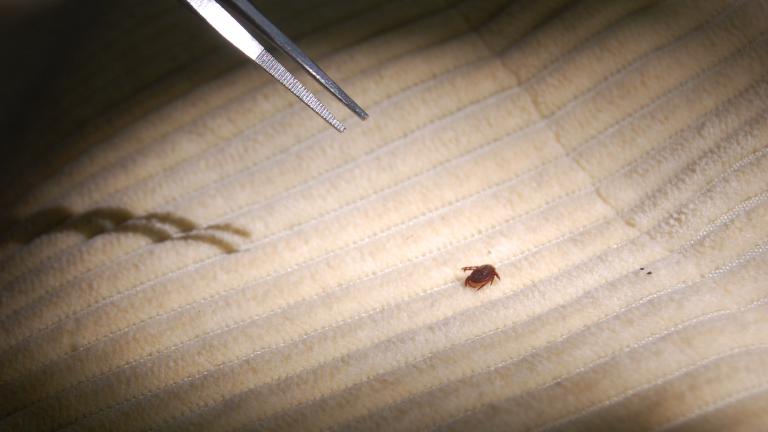With the onset of summer fast approaching, the Macomb County Health Department would like to inform residents that ticks are currently active in Macomb County and across the state of Michigan, and that there are steps and actions that can be taken to prevent illnesses spread by ticks, such as Lyme disease.
“Because we have had a relatively mild winter and spring season, there is an elevated probability of the presence of ticks,” said Tom Barnes, division director of the Macomb County Health Department’s Environmental Health Division. “So as we start to spend more and more time outdoors in the spring and summer, we all need to be mindful of the presence of ticks and some of the strategies to avoid tick bites, and potentially, Lyme disease."
According to the 2022 Michigan Emerging and Zoonotic Disease Surveillance Study, the state of Michigan has experienced increased growth of Lyme disease - from 262 cases in 2018, to a high of 862 in 2021 to 546 in 2022. Eleven of the 546 cases in 2022 were identified in Macomb County. In addition, Macomb County has also experienced a steady increase of Lyme disease over the past eight years, with three cases in 2016 to 15 cases in 2023.
Lyme disease is caused by bacteria and is spread through the bite of infected blacklegged ticks (also known as deer ticks). The presence of the blacklegged tick in Michigan is growing. In fact, based on the Michigan Department of Health and Human Services’ 2024 Michigan Lyme Disease Risk Map, 81 of Michigan’s 83 counties have a known risk for Lyme disease, or potential risk for Lyme disease. Local surveillance efforts by the Macomb County Health Department on blacklegged ticks that were collected in 2021 and 2022 tested positive for the bacteria that causes Lyme disease. Test results on blacklegged ticks that were collected in 2023 are currently not available.
Ticks can attach to any part of the human body but are often found in hard-to-see areas such as the groin, armpits, and scalp. In most cases, the tick must be attached for 36-48 hours or more before Lyme disease can be transmitted. Because of this, doing a full-body check to find and remove ticks after spending time outdoors is important. Ticks should be removed by grasping the tick with fine-tipped tweezers as close to the skin as possible and pulling upward with steady, even pressure.
If someone is bitten by a tick that is suspected or confirmed to be a blacklegged tick, they should call their healthcare provider. Symptoms of Lyme disease include fever, headache, and fatigue. Many people, but not all, will get a characteristic “bull’s-eye” skin rash. If untreated, infections can become serious. Most cases of Lyme disease can be treated successfully with antibiotics. Here are some suggestions to help avoid ticks:
Before You Go Outdoors:
- Know where to expect ticks. Blacklegged ticks are commonly found on low forest vegetation, often along human and animal trails.
- Wear long-sleeved shirts and tuck pants into socks. Wear boots or shoes instead of sandals.
- Treat clothing and gear with products containing 0.5% permethrin or you can buy permethrin-treated clothing and gear.
- Use Environmental Protection Agency (EPA)-registered insect repellents. To help find the repellent that is right for you, the EPA has a search tool that can be found here https://www.epa.gov/insect-repellents/find-repellent-right-you
After You Come Indoors:
- Check your clothing for ticks. Any ticks that are found should be removed. Tumble dry clothes in a dryer on high heat for 10 minutes to kill ticks on dry clothing after you come indoors.
- Examine gear and pets. Ticks can get into the home on coats, clothing, pets, and daypacks.
- Check your body and your child’s body for ticks after being outdoors: under the arms, in and around the hair and ears, inside the belly button, the waist and back, back of the knees and between the legs and pelvic area.
- Showering within two hours of coming indoors may help wash off unattached ticks; it is also a good opportunity to do a tick check.
The Centers for Disease Control and Prevention has a number of tick-related resources and suggestions to prevent tick bites that can be found at https://www.cdc.gov/lyme/prev/index.html.
The Macomb County Health Department is actively monitoring the population of ticks in the county to identify any changes or migration. For more information from the Michigan Department of Health and Human Services on ticks and Lyme disease, visit https://www.michigan.gov/mdhhs/safety-injury-prev/environmental-health/topics/mitracking/ticks.
Images of Macomb County Health Department tick surveillance activities can be found here.
Scott Turske
586-243-6321
scott.turske@macombgov.org







